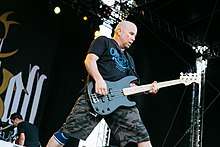Thrashcore
Thrashcore (also known as fastcore) is a fast tempo subgenre of hardcore punk that emerged in the early 1980s. Thrashcore is essentially sped-up hardcore, often using blast beats. Songs can be very brief, and thrashcore is in many ways a less dissonant, less metallic forerunner of grindcore. The genre is sometimes associated with skateboarder subculture.
| Thrashcore | |
|---|---|
 Craig Setari of New York thrashcore band Straight Ahead. | |
| Other names | Fastcore |
| Stylistic origins | |
| Cultural origins | Early 1980s, United States |
| Typical instruments | |
| Derivative forms | |
| Other topics | |
Terminological ambiguity
Thrashcore is often confused with crossover thrash and sometimes thrash metal.[3][4] Further confusion is added by the fact that many crossover bands, such as D.R.I., began as influential thrashcore bands.[3] Throughout the '80s, the term "thrash" was in use as a synonym for hardcore punk (as in the New York Thrash compilation of 1982). It eventually came to be used for the faster, more intense style of hardcore punk. The term thrashcore is of recent vintage but dates from at least 1993.[5] The "-core" suffix is necessary to distinguish it from the thrash metal scene, which is also referred to as "thrash" by fans. Still more confusingly, the term "thrashcore" is occasionally used by the music press to refer to thrash metal-inflected metalcore.[6]
History
Origins
Just as hardcore punk groups distinguished themselves from their punk rock predecessors by their greater intensity and aggression, thrashcore groups (often identified simply as "thrash") sought to play at breakneck tempos that would radicalize the innovations of hardcore. Early American thrashcore groups included Cryptic Slaughter (Santa Monica), D.R.I. (Houston), HYPE (Toronto Canada), Septic Death (Boise, Idaho) and Siege (Weymouth, Massachusetts). The British Electro Hippies, the Dutch Lärm, the Italian Raw Power, and the Japanese S.O.B. also practiced important examples of the style. Some of Negative Approach's later work was influential on the scene.
Powerviolence
The powerviolence scene grew out of thrashcore as an American counterpart to the British grindcore scene, which had emerged from crust punk, with bands such as Septic Death, Infest and Siege being the first to move towards the style.[7] Powerviolence groups saw themselves as distinct from grindcore because of the increasing proximity of grindcore groups to the death metal being performed in Florida, Sweden, and Brazil.[8] Powerviolence groups wished to avoid the association with heavy metal music and culture that crossover thrash, thrash metal, and grindcore had made, while also incorporating "tempo changes with droney and sludgey down tempo parts".[7] As well as from thrashcore, powerviolence groups also took inspiration from crust punk, and eventually from noise music. Main groups associated with powerviolence included No Comment, Hellnation, Man Is The Bastard, Crossed Out, Charles Bronson, Spazz and Rorschach.
Grindcore
Thrashcore groups such as S.O.B.,[9][10][11] Cryptic Slaughter,[12] Siege and Deep Wound[13] were major influences on early grindcore acts such as Napalm Death, Carcass and Repulsion, however grindcore is considered to be more metallic, due to its influence from crust punk.[7][13]
Thrashcore revival

The '90s saw a revival of the thrashcore style, as groups that had previously been associated with powerviolence or grindcore began to explore their debt to this earlier form of extreme rock music. This was sometimes referred to as "bandanna thrash", in reference to the headgear preferred by many of the performers.[14] Prominent '90s thrashcore groups included Refused, Code 13, MK-ULTRA, Guyana Punch Line, What Happens Next? and R.A.M.B.O. (from the United States), Vitamin X (from the Netherlands), Vivisick (from Japan), and Voorhees (from the UK). These groups sometimes felt a greater association with other elements of '80s hardcore punk, such as straight edge, anarcho-punk, youth crew, or crust punk, than most initial thrashcore groups did.
Contemporary thrashcore
Some prominent American thrashcore groups of the 21st century include Limp Wrist, Das Oath and Trash Talk.
Record labels
Notes
- Roddy, Derek (2007). The Evolution of Blast Beats. p. 22. ISBN 978-1423460169.
- Von Havoc, Felix (1984-01-01). "Rise of Crust". Profane Existence. Archived from the original on 2008-06-15. Retrieved 2008-06-16.
- Felix von Havoc. Maximum Rock'n'Roll #198. Retrieved June 20, 2008.
- "Powerviolence: The Dysfunctional Family of Bllleeeeaaauuurrrgghhh!!". Terrorizer no. 172. July 2008. p. 36-37.
- As Max Ward writes, "625 started in 1993 in order to help out the local Bay Area thrashcore scene." Ward, Max (2000). "About 625". 625 Thrashcore. Retrieved June 5, 2008.
- Voegtlin, Stewart (July 29, 2008). "Soulfly Cranks Up the Thrash and Triggers a Debacle". Village Voice. Retrieved July 31, 2008.
- Preenson, Richard. "What Even is "Thrashcore" Anyway?". Thrown Into the Fire. Retrieved 4 March 2018.
- Bartkewicz, Anthony (July 2007). "Screwdriver in the Urethra of Hardcore" Archived 2008-02-24 at the Wayback Machine. Decibel Magazine. Retrieved July 29, 2007.
- "S.O.B – METALBROTHERS.ES – Todo el Metal – All about Metal". metalbrothers.es. Retrieved 18 January 2018.
- "The Lazarus Pit: SOB's What's the Truth? - Decibel Magazine". 12 October 2012. Retrieved 18 January 2018.
- Niesel, Jeff. "Grindcore Meets Grunge: Napalm Death and the Melvins Bring Co-Headlining Tour to Agora". Retrieved 27 November 2017.
- Farrar, Justin (2017-12-26). "The 30 Greatest Thrash Bands of All Time". Spin. Retrieved 20 July 2018.
- Mudrain, Albert. Choosing Death. p. 21.
- Interview with Max Ward. Maximum Rock'n'Roll. Retrieved June 19, 2008.
Bibliography
- Blush, Steven (2001). American Hardcore: A Tribal History. Feral House. ISBN 0-922915-71-7